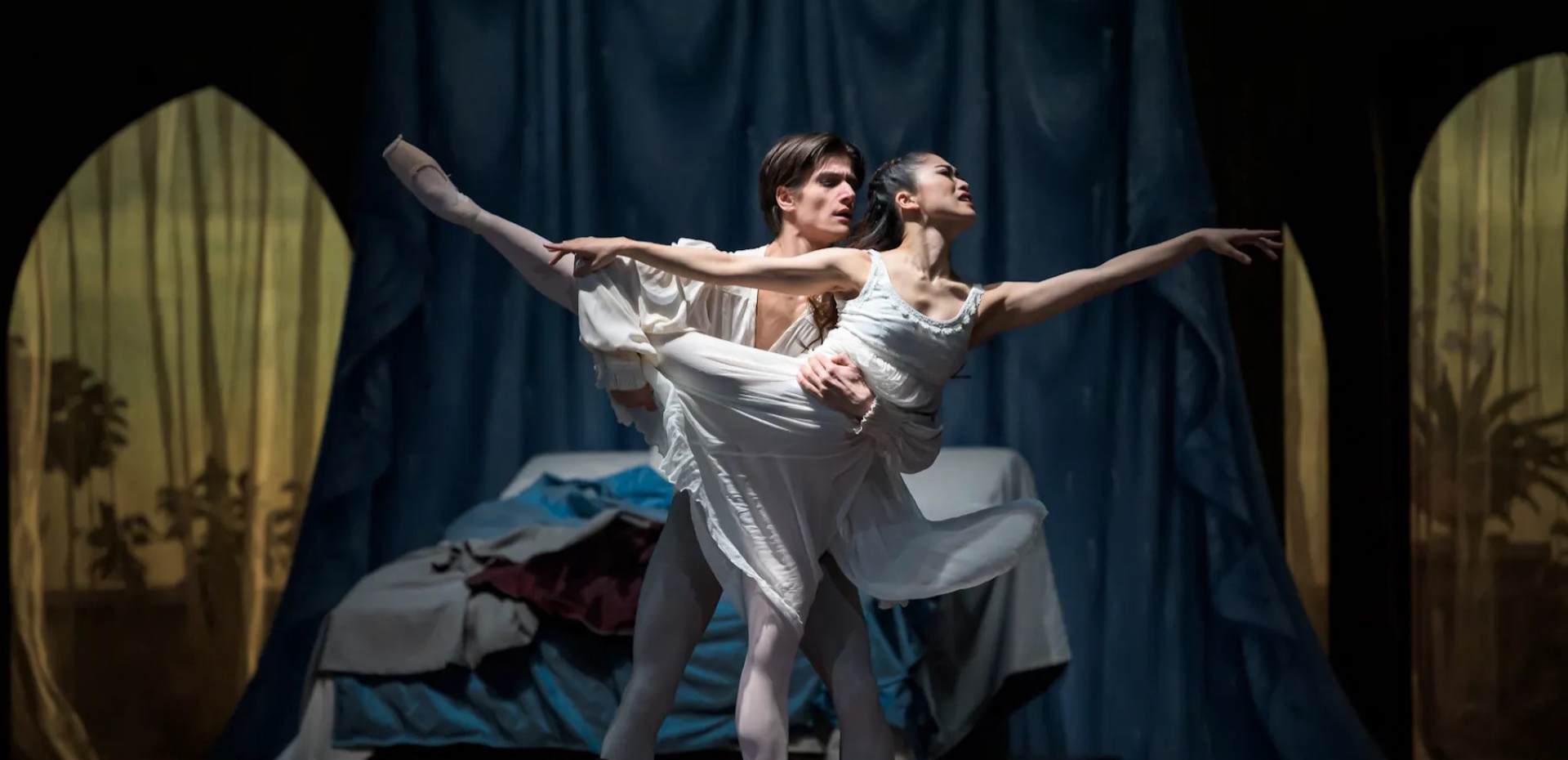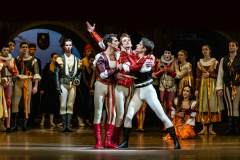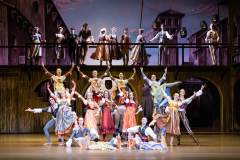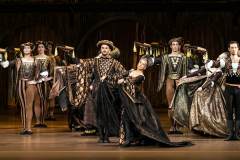Romeo and Juliet
Mo | Tu | We | Th | Fr | Sa | Su |
Romeo and Juliet - Sergei Prokofiev
Ballet by John Cranko after William Shakespeare
Approximate running time: 2 hours 30 minutes, 2 intermission (20 minutes)
Ever since its premiere eight decades ago, Sergey Prokofiev’s Romeo and Juliet has been performed by renowned companies worldwide, as one of the pillars of the classical ballet repertoire.
John Cranko originally created an adaptation of Romeo and Juliet for the ballet company of La Scala in Milan, whose production featured the celebrated prima ballerina Carla Fracci and the dancer Mario Pistoni in the title roles. Four years later, in 1962, the Stuttgarter Ballett, which he helmed, presented a revised version, starring Márcia Haydée and Ray Barra. Cranko’s production is still immensely popular and part of the repertoire of numerous globally renowned companies (National Ballet of Canada, Australian Ballet, Paris Opera Ballet, Vienna State Ballet, Joffrey Ballet in Chicago, Teatro Municipal de Santiago in Chile, Finnish National Ballet, National Ballet of China in Beijing, Bavarian State Ballet, Boston and Washington Ballets, etc.).
Our new production of Cranko’s adaptation of William Shakespeare’s immortal tale, forcibly conveying human emotions, features the globally renowned designer Jürgen Rose’s original enthralling sets and costumes.
Suitable for audience from 12 years
Program and cast
Lord Capulet: Fraser Roach, Radek Vrátil, Jiří Kodym
Lady Capulet: Miho Ogimoto, Michaela Černá, Romina Contreras
Juliet: Ayaka Fujii, Evgeniya Victory Gonzalez, Nina Fernandés, Alina Nanu, Irina Burduja, Romina Contreras, Aya Okumura, Haruka Iguchi
Tybalt: Sami Gossart, Fraser Roach, Giovanni Rotolo, Paul Tudor Moldoveanu, Marek Svobodník
Count Paris: John Powers, Oleg Ligaj, Jonáš Dolník, Danilo Lo Monaco
Nurse: Nelly Danko, Jana Jodasová, Klára Jelínková, Michaela Černá
Lord Montague: Oleg Ligaj, Marek Svobodník, Fraser Roach
Lady Montague: Monika Hejduková, Rachel Hickey, Natálie Trešlová
Romeo: Paul Irmatov, Adam Zvonař, Erivan Garioli, Federico Ievoli, Patrik Holeček, Brooks Landegger
Mercutio: Elias Frantziskonis, Giovanni Rotolo, Veaceslav Burlac, Matěj Šust, Erivan Garioli, Paul Irmatov
Benvolio; Robert Jerjen, Jakub Rašek, Giacomo De Leidi, Oleg Ligaj, Francesco Scarpato, Ryo Hinoue, Elias Frantziskonis
Duke of Verona: Alexey Afanasiev, Mathias Deneux, Alexandre Katsapov, Edward Harper
Friar Laurence: Alexey Afanasiev, Mathias Deneux, Alexandre Katsapov, Edward Harper
Rosaline: Anna Dal Castello, Monika Hejduková, Chihiro Sudo
Gypsy Women: Irina Burduja, Alexandra Pera, Olga Bogoliubskaia, Anna Dal Castello, Eriona Bici, Anna Novotná, Aya Okumura, Natsuki Nishiyama, Kristýna Němečková, Diana Alonso, Louise Corpechot, Nina Fernandés
Carnival King: John Powers, Danilo Lo Monaco, Marek Kašparovský, Luca Novello
Music: Sergei Prokofiev
Choreography: John Cranko
Choreology and staging: Jane Bourne
Staged by Filip Barankiewicz
Sets and costumes: Jürgen Rose
Light design: Jürgen Rose, Valentin Däumler
Costume supervision: Diana Eckmann
Sets reconstruction: Martin Černý
Ballet master: Alexey Afanasiev , Michaela Černá, Nelly Danko, Jiří Kodym, Tereza Podařilová, Alexandre Katsapov, Radek Vrátil
Music preparation, conductor: Václav Zahradník
Prague State Opera
The State Opera today
The State Opera (formerly the State Opera Prague, between 1948 and 1992 the Smetana Theatre, and originally the New German Theatre) has been a part of the National Theatre since 2012. The Opera and Ballet ensembles give repertory performances at the State Opera.
History
The Prague State Opera resides in the building which on January 5, 1888 was opened as a Prague German stage with the performance of Wagner’s opera, The Mastersingers of Nürnberg. In the 19th century, Prague Germans performed in the Estate’s Theater in alternation with a Czech company. Desire for their own theater led to negotiations in 1883 for the construction of a new theater building for the German Theater Association. Over the next three years, a blueprint was drawn up and handed over to the Vienna atelier of Fellner and Hellmer. Also sharing in the design was the architect of the Vienna Municipal Theater, Karl Hasenauer, while Prague architect Alfons Wertmüller took part in the construction. Financing came from private collections. With its spacious auditorium and neo-Rococo decoration, this theater building is among the most beautiful in Europe.
Access:
By car
On Wilsonova street, from the left lane close to the State Opera building take the slip road to the Slovan above-ground garage. The parking fee is 40 CZK/h.
By tram
By daytime tram No. 11 to the stop “Muzeum”, through the underpass beneath Legerova street in the direction of the NationalMuseum, at the crossroads turn right along the NewBuilding of the NationalMuseum.
By daytime trams Nos. 3, 9, 14 and 24 or night trams Nos. 51, 52, 54, 55, 56 and 58 to the stop “Václavské náměstí”, then by foot uphill on the left side of the Wenceslas Square to the traffic lights across Wilsonova and Vinohradská streets. Then turn left along the NewBuilding of the NationalMuseum.
By metro
To the “Muzeum” station, lines A and C (green and red), and then by foot along the NewBuilding of the NationalMuseum.

 EN
EN DE
DE IT
IT FR
FR ES
ES RU
RU JP
JP RO
RO
 Seating plan
Seating plan 



